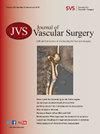即将毕业的血管外科学员对血管内和开放式外周血管重建手术的熟练程度。
IF 3.9
2区 医学
Q1 PERIPHERAL VASCULAR DISEASE
引用次数: 0
摘要
导言:鉴于微创方法的固有优势,外周动脉疾病的血管内介入治疗随着时间的推移越来越普遍。虽然血管外科毕业生必须熟练掌握血管内技术,但 BEST-CLI 试验的结果也强调了确保受训者掌握开放手术技能的同等重要性。最近的研究表明,在血管外科培训期间,血管内手术和开放手术的病例量都在增加。然而,病例量只是能力的替代指标,受训者在毕业时达到的客观能力尚不清楚。我们试图调查即将毕业的血管外科学员在进行血管内和开放式外周血管再植手术时的手术自主性和能力:从提高专业学习学会手术(SIMPL OR)应用数据库中收集了2018-23年所有血管外科参与机构的腹股沟下血管内再植和开放式血管内再植的手术表现和自主性评分。自主性和绩效评分的分布分别按血管内手术和开放手术的培训级别确定。在调整了培训水平和病例复杂程度后,进行了混合效应逻辑回归,以估计手术类型与自主性和绩效评估之间的预测关联。随后,应用估算出的模型来预测即将毕业的学员在进行血管内手术和开腹手术时,在不同的病例复杂度下被评为有意义的自主或胜任的概率:来自 23 个项目(12 个研究员项目,11 个住院医师项目)的 69 名住院医师接受了 706 例血管重建手术(血管内手术 383 例,开放手术 323 例)的评估。在控制了培训水平和病例复杂程度后,血管内外周血管重建手术的自主性(OR 1.11 [95% CI: 0.62-1.99])或能力评估(OR 0.86 [95% CI: 0.46-1.59])与开放性相比没有差异。就平均复杂程度的手术而言,学员在毕业时被评估为胜任和自主的预测概率很高(胜任:88%的血管内手术,86%的血管外手术):88%为血管内手术,86%为开放手术;96%为血管内手术,97%为开放手术)。对复杂手术的胜任和自主预测概率较低,但各组之间仍然相似(胜任:73%血管内手术,70%开放手术;自主:92%血管内手术,92%开放手术):结论:与开放式外周血管重建手术相比,血管外科受训人员的自主性和能力毕业水平没有差异。这些研究结果表明,血管外科学员在进入独立执业阶段时已具备足够的熟练程度,可以利用各种技术为需要进行外周血管重建手术的患者提供治疗。本文章由计算机程序翻译,如有差异,请以英文原文为准。
Graduating vascular surgery trainee proficiency in endovascular and open peripheral revascularization procedures
Background
Endovascular interventions for peripheral artery disease have increased in prevalence over time given the inherent benefits of minimally invasive approaches. Although it is essential that vascular surgery graduates are facile with endovascular techniques, the results of the BEST-CLI (Best Endovascular vs. Best Surgical Therapy in Patients With Critical Limb Ischemia) trial highlight the equivalent importance of ensuring trainee competence in open skills. Recent studies demonstrate increasing case volume of both endovascular and open procedures during vascular surgery training. Case volume is merely a surrogate marker for competence, however, and the objective competence attained by trainees at the time of graduation is unknown. We sought to investigate operative autonomy and competence of graduating vascular surgery trainees performing endovascular as compared with open peripheral vascular revascularization procedures.
Methods
Operative performance and autonomy ratings for infrainguinal endovascular and open revascularizations from the Society for Improving Professional Learning Operative application database were collected for all vascular surgery participating institutions from 2018 to 2023. The distribution for autonomy and performance ratings were determined by training level for endovascular and open procedures, respectively. Mixed effects logistic regressions were conducted to estimate the predictive association between procedure type and autonomy and performance assessment, adjusting for training level and case complexity. Subsequently, the estimated model was applied to predict the probability of a graduating trainee being rated as meaningfully autonomous or competent while performing endovascular and open procedures across various case complexities.
Results
Sixty-nine residents from 23 programs (12 fellowship, 11 residency) were assessed on 706 revascularization procedures (n = 383 endovascular; n = 323 open). When controlling for training level and case complexity, there were no differences in autonomy (odds ratio [OR], 1.11; 95% confidence interval [CI], 0.62-1.99) or competency assessment (OR, 0.86; 95% CI, 0.46-1.59) for endovascular, as compared with open, peripheral revascularization procedures. For average complexity procedures, the predicted probability of a trainee being assessed as competent and autonomous at the time of graduation was high (competent: 88% endovascular, 86% open; autonomous: 96% endovascular, 97% open). The predicted probability of competence and autonomy for complex procedures was lower, but remained similar between groups (competent: 73% endovascular, 70% open; autonomous: 92% endovascular, 92% open).
Conclusions
There is no difference in the graduating level of autonomy and competence of endovascular as compared with open peripheral revascularization procedures for vascular surgery trainees. These findings suggest that vascular surgery trainees enter independent practice with adequate proficiency to use the full scope of techniques to care for patients requiring peripheral revascularization procedures.
求助全文
通过发布文献求助,成功后即可免费获取论文全文。
去求助
来源期刊
CiteScore
7.70
自引率
18.60%
发文量
1469
审稿时长
54 days
期刊介绍:
Journal of Vascular Surgery ® aims to be the premier international journal of medical, endovascular and surgical care of vascular diseases. It is dedicated to the science and art of vascular surgery and aims to improve the management of patients with vascular diseases by publishing relevant papers that report important medical advances, test new hypotheses, and address current controversies. To acheive this goal, the Journal will publish original clinical and laboratory studies, and reports and papers that comment on the social, economic, ethical, legal, and political factors, which relate to these aims. As the official publication of The Society for Vascular Surgery, the Journal will publish, after peer review, selected papers presented at the annual meeting of this organization and affiliated vascular societies, as well as original articles from members and non-members.

 求助内容:
求助内容: 应助结果提醒方式:
应助结果提醒方式:


